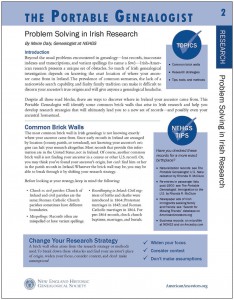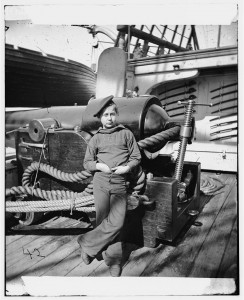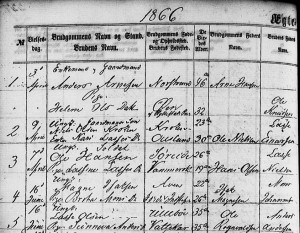The National Archives’ Records of the Immigration and Naturalization Service—which many genealogists informally call “Record Group 85”—is one of the best sources of data on immigrants to America, covering the years 1787 to 1993. It’s a common misperception that Record Group 85 contains only passenger lists, which are now viewable online through many sites. However, this record group contains hundreds of case files of immigrants either trying to come into the United States or trying to stay in the country. Also hiding in this series are documents that introduce us to what immigrants were expected to learn about their adopted country in different periods. Continue reading Becoming American: A Look at the Process
Tag Archives: Research tips
A helping hand

Before I began researching my ancestry, I was overwhelmed by the undertaking. It seemed like an impossible task that would take up all my time — trying to make sense of all those great-great-great-greats with their shifting residences, repeating names, and overlapping dates. I’ve always been bad with numbers and dates, and tend to be distracted by anything new and exciting, so my past attempts at uncovering information about my ancestors have resulted in a confusing game of Internet hopscotch through random records I couldn’t really understand concerning people to whom I may or may not have been related. I had convinced myself that I was uniquely ill equipped for genealogical research.
But kind fate reached out a helping hand in the form of my friend and colleague Chris Child. Not only is Chris a really nice guy, he’s one of the smartest people I’ve ever met, and a legend in the genealogical community. He offered to help me begin and guide me through my research. I accepted immediately, before he could change his mind. Continue reading A helping hand
Census records for tracking economic mobility

For a school assignment, my daughter had to identify a family member who rose in social and economic class through means of employment and education opportunities. I immediately thought of her great-great-grandparents, Louis and Emma. Each had emigrated from Austria to New York, where they met, married, and had ten children, including her great-grandmother, Anna. I knew that the family had lived on the Lower East Side of Manhattan, and that Louis had been a tailor in a factory. But I did not really know much beyond that except that at some point the family had moved out of the tenements, and some of the Anna’s siblings had professional occupations. I suggested that we examine census records to find out more. Continue reading Census records for tracking economic mobility
Church records in early New England research

Church records can be a valuable resource when vital records fall short. NEHGS has a large collection of published church records for New England and throughout the United States. For learning more about the Church family of Plymouth County, Massachusetts, Congregational Church records, held by the Congregational Library and Archives on Beacon Street in Boston, have also proved especially helpful.
A Caleb Church of Hanover purchased land in Rochester, Plymouth, Massachusetts in 1770, went on to marry a woman named Hannah Pool in 1772, and died in 1827. However, the ancestry of Caleb Church was a mystery. Though he was listed in the 1770 land record as being originally “of Hanover,” there was no birth record for Caleb Church in the Hanover Vital Records.[1] Continue reading Church records in early New England research
A surprising brush with history

My husband inherited several dozen Civil War–era letters from his great-great-grandmother Susan (Berry) Dill and her daughter, Ida Alice Dill, who lived in Sangamon and Christian Counties, Illinois. Ida married Frank Stratton, the brick wall in my husband’s ancestry. One day, in frustration at not finding anything about Frank, I took to Google and entered a string of names and dates from the letters: George Elizabeth Susan Benjamin Berry Christian County Illinois 1850 1860—something like that. If no clue to Frank turned up, I figured, I would learn more about the Berrys. And indeed I did. Continue reading A surprising brush with history
Resources for World War I research

One of the things I enjoy most about family research is to go beyond locating ancestors’ names and the dates of birth and death, and find out as much as I can to develop a picture of their lives. I want to know where they lived, what they did for a living, what their hobbies were, etc. I also like to try to place my ancestors in a broader historical context.
Like many of you, I have connected ancestors to World War I. When approaching a topic as daunting and nuanced as the Great War, I figure that one can never know enough. Luckily, there are a wide variety of resources available. Here are some my favorites: Continue reading Resources for World War I research
Researching your Irish ancestors
 It’s St. Patrick’s Day! What better time to review NEHGS resources — both in print and online — that can help you research your Irish ancestors? Irish research offers particular challenges, largely owing to the destruction of many records in a 1922 fire at the Public Record Office in Dublin.
It’s St. Patrick’s Day! What better time to review NEHGS resources — both in print and online — that can help you research your Irish ancestors? Irish research offers particular challenges, largely owing to the destruction of many records in a 1922 fire at the Public Record Office in Dublin.
One great resource for getting you started is the Portable Genealogist Problem Solving in Irish Research, written by Marie E. Daly (who herself is a valuable NEHGS resource for Irish research). Marie notes that “the prevalence of common surnames, the lack of a nationwide search capability, and faulty family tradition can make it difficult to discern your ancestor’s true origins and will give anyone a genealogical headache.” To help readers, the guide identifies common brick walls that you might encounter and helps you identify research strategies. For instance, a little checklist notes records for determining a more exact birthplace. The guide also addresses some common assumptions that prevent researchers from moving forward with their Irish research. Continue reading Researching your Irish ancestors
Dowry versus Dower Right

Family historians use a variety of records, some of which require some understanding of legal terms. And when it comes to land records, one term that is very often misunderstood is dower. Many look at that word and think of dowery. While both terms have to do with women, marriage, and property, they have different meanings. Continue reading Dowry versus Dower Right
Young New Hampshire Mariners

Do you have an ancestor from New Hampshire who was working at sea at the young age of 10 or 12? Have you seen a U.S. Federal Census record that states that your ancestor was a “mariner” at age 13? Did you think it was a mistake or an oversight? In fact, many boys as young as 10 were working on ships in New Hampshire in the late 1700s and early 1800s. Continue reading Young New Hampshire Mariners
My family is Scandinavian . . . now what?!

In the years after the American Civil War, an influx of immigrants from Scandinavia settled in the United States. Pushed from their homelands by famine, overpopulation, and lack of economic opportunities, these Swedes, Norwegians, Finns, and Danes poured into the country. In particular, they were drawn to the American Midwest, where large tracts of fertile farmland were abundant. Here they established their own communities, where they spoke their mother language, established their own churches, and even published their own newspapers. Today many Americans can claim Swedish, Norwegian, Finnish, and Danish ancestry. And if you are one of these Americans, you may be apprehensive about researching these ancestors because of the language barrier. Don’t be; with the right base of knowledge and a little practice, you’ll be well on your way to uncovering your Scandinavian roots. Continue reading My family is Scandinavian . . . now what?!